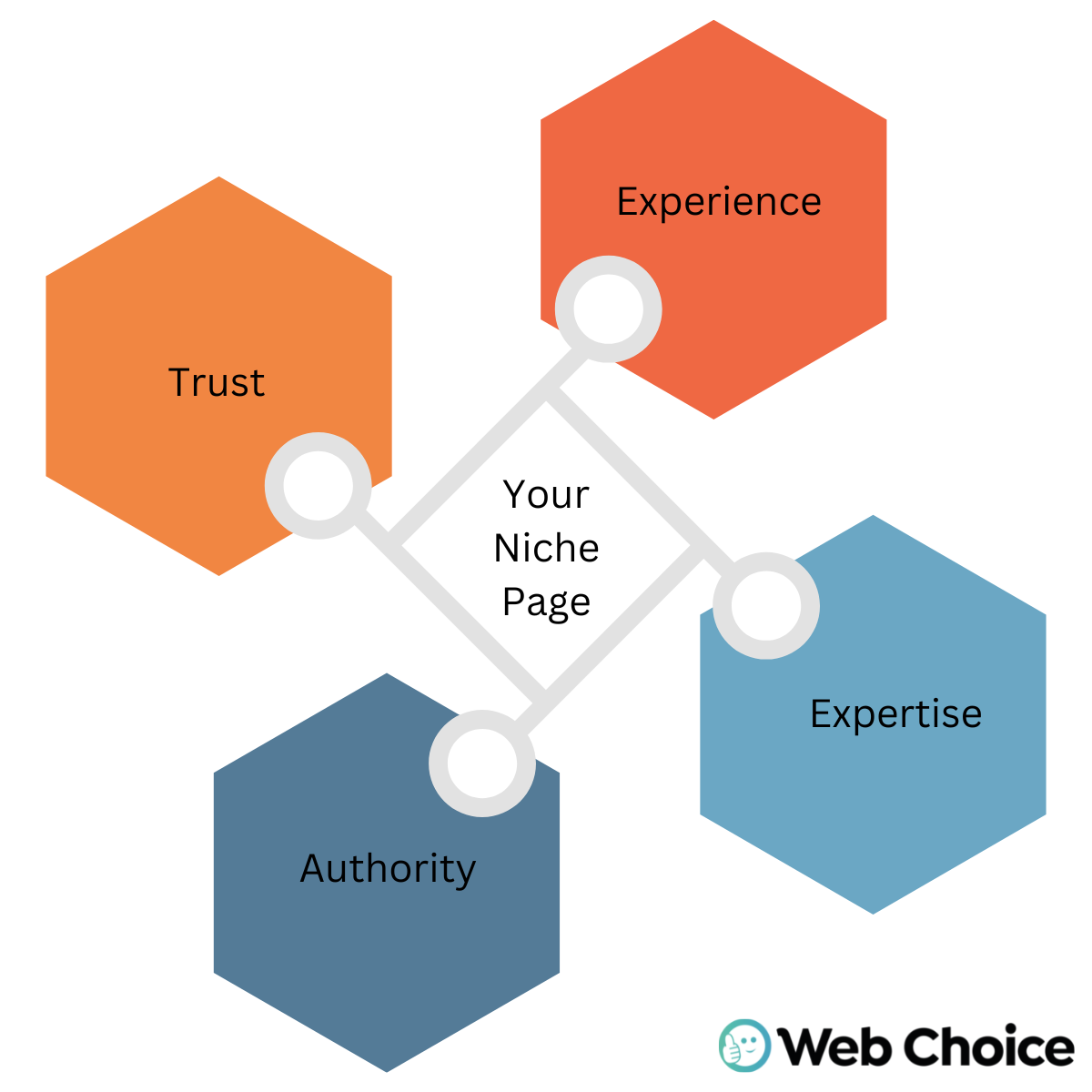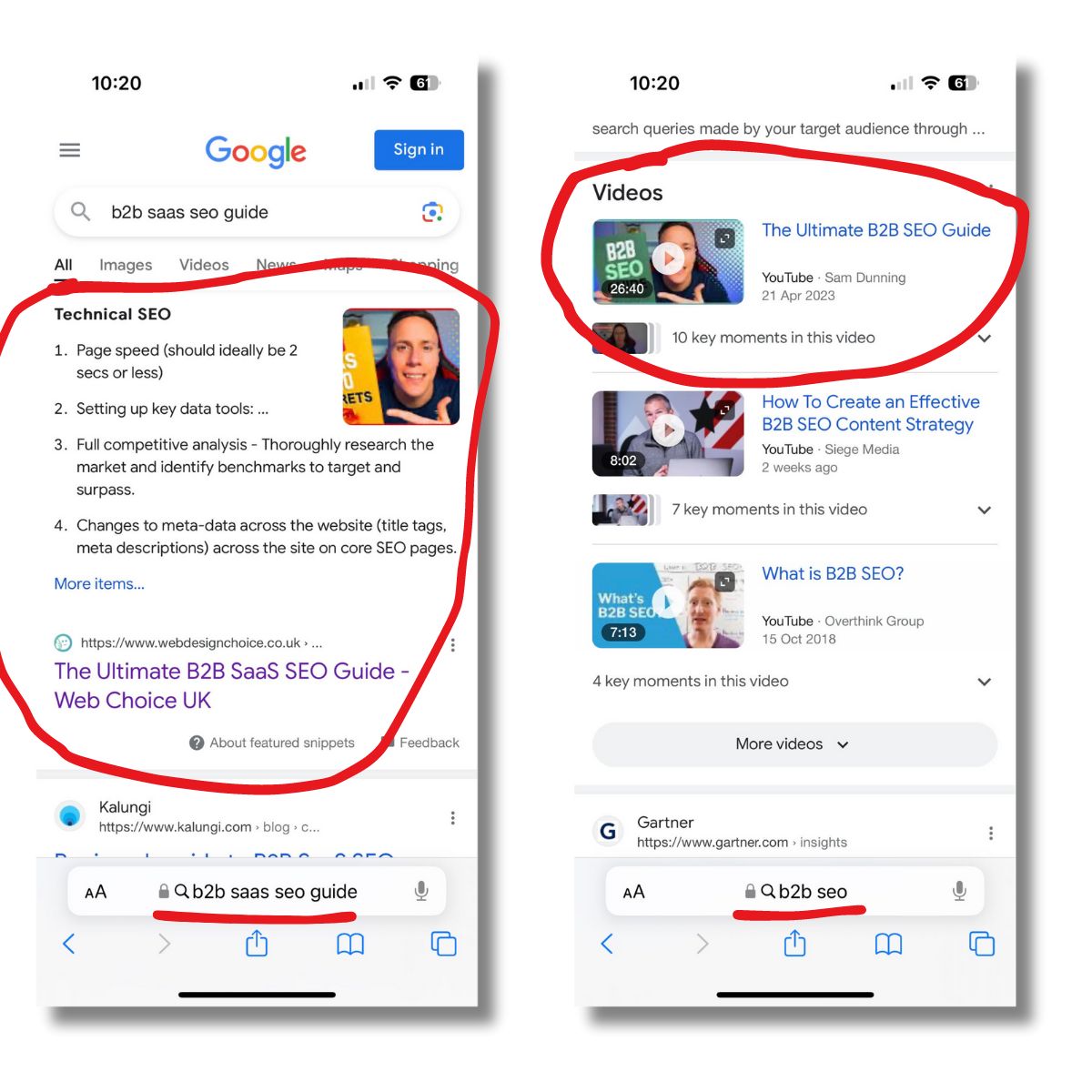Stop competitors stealing your inbound on Google.
I’m sharing a walkthrough so your B2B SaaS/Service/Tech company can drive serious revenue with organic search AKA SEO and make it a sustainable source of lead, consult & demo requests for your team.
Create an evergreen ecosystem of organic content that can rank on Google from now and for years to come attracting inbound leads while you sleep.
Building a solid SEO strategy puts multiple lines in the water on Google to build an organic inbound engine to come up top whenever your prospects want to learn about your industry or speak to sales.
Plus, you can reduce your ad spend over time as your organic traffic and inbound leads increase.
A solid website designed to attract, build trust with, qualify and convert ideal clients. That works seamlessly on mobile and PC. It needs a design that engages prospects along with messaging that resonates with their problems and key goals.
Not sure if SEO is a good fit?
Unless you are in a brand new category/sector or extremely niche market no one knows exists…then SEO is gonna be worth your time as a SaaS company.
SEO needs to be looked at as an investment into your brand, website and organic revenue growth.
Let’s get stuck into it.

It’s time to ditch traditional keyword research where we only rely on software and tools.
Your ideal clients and prospects are the best source of rocket fuel for the right search terms to target and content to create.
From them you’ll learn the most common questions, objections and problems that they have.
Plus you can know the actual words they use to describe your solution. Rather than guessing.
Get together with your sales team and make a list of all the questions, problems and objections regularly brought up.
And listen to sales calls using tools like Gong or similar to find the hidden gems your customers regularly want answers to.
And then, once you’ve got your detailed list created, you can do traditional keyword research too (this list will come in useful for long-tail keyword research / content for pages along with FAQs for pages that your prospects are actually searching for).
Start with the high buying intent searches related to your offer - e.g. if you provide software to help sales teams these might be keywords like: ‘proposal software’, ‘sales recording tools’, ‘buyer enablement software’ etc.
There’s money in the long tail. So the more specific to the offer and industry you want to attract inbound from, the better.
Rather than going after a hugely competitive and generic term like ‘CRM’ you could go specific to your key target industry e.g. ‘CRM software for accounting’
Long tail keywords can rank faster and also provide better quality leads from your ideal target markets.
Common tools used for SEO keyword research: Semrush, Ahrefs, Google keyword planner, Ubersuggest.
Other ideas for keyword research:
This is everything you do on your website to benefit your organic rankings.
The two main elements of on- page SEO are the technical build of your site and the content that makes up your pages.
This typically starts with an audit of your website. Sorting things like:
So from a SaaS point of view you want to build a page for every feature / target market / use case that your prospects customers could be searching for.
The best way to do this is to start with the high buying intent search terms you identified during keyword research.
Then build out a page for each key offering that matches the search intent.
Here’s a simple way to build pages on your site that rank…
Review the top 3 organic results for your chosen search terms.
Build your service, product page or article page for buyers.
This means you've gotta know your ideal clients cares, problems, objections and goals.
And bare in mind Google's update E- E-A-T (Experience, Expertise, Authority, Trust).

For example on a detailed service/solution page we tend to go:
Overview of the offering Common problems it fixes Why you need it Processes + video guide
How to's Examples/case studies Pricing
FAQs
Weaving in relevant social proof (testimonials, videos, reviews)
And descriptive CTAs for visitors to take the next step.
Craft a solid design for mobile and PC view.
Build out technical SEO points (meta title + description, image tags, heading tags, add a couple relevant internal links in page etc).
Repeat for all your money search terms and offerings.
At Web Choice we followed this framework to outrank some huge SaaS companies like Salesforce and Webflow.
Recently did it to get page 1 for 'B2B SEO Company' in UK/EU and some other regions.
We also nailed 'web development company' page 1 in same locations.
Once you have covered all the high intent search terms for target clients/sectors wanting your solution…move onto blog articles answering all your clients main problems and questions around key offers.
Again your prospects/customers are the best source of knowledge to fuel your articles content. Because you know the demand is their if they are often raised in conversation
So this is everything you do off of your website.
Off-page SEO is especially important for when you want to get competitive and more generic keywords ranking.
One of the best ways to do this is building backlinks.
Google see’s backlinks as a trust building factor for your site.
They can build up your website's domain authority and help get those hard to rank pages up in the organic search results on Google.
A few ways to build backlinks:
Want an unfair SEO advantage?
Grab 2 spots on Google's results page using video.
A sneaky way to get top for competitive keywords.
Make an in-depth YouTube video for the target search term.
And embed the tailored video to your article/page.

These pages often rank better.
And can show the video thumbnail on search results pages - upping click through rates.
PLUS
While your waiting for the page to rank Your video can rank in the video section
And eventually both normal organic and video sections
I've done it for a bunch of our services.
Getting Stakeholder Buy-In For SEO
SEO can be a bloody tough internal sell.
Here's 3 tips to leverage.
Tip 1: C-Suite want results fast.
And whilst you can see an impact on inbound pipeline on well executed SEO in 3 months.
That's not always enough for marketing/revenue leaders to get buy in...
Moving from pain can be. Here's the pain to leverage
Every time a prospect needs our solution and searches for:
Stealing traffic and inbound oppurtinities from high-intent prospects.
Every day.
Sooner you start SEO.
The sooner you can start enjoying a long-term sustainable flow of inbound with organic search.
(provided you're in an established sector or category that has market demand)
Tip 2 (juicy):
Introducing evergreen content. Searchable. Owned. Goodness.
The ridiculous fact your web pages and articles can attract traffic and leads not just today…
But for years to come.
Some use cases:
Knowing what your focus buyers care about and building content/media on your site nailing it.
Each page is a searchable asset your business owns.
Think when you search on YouTube and videos months or even YEARS old show up.
SEO content is like this.
If you nail the strategy...
You’ll get a steady stream of organic opportunities for the long term.
Something paid channels can’t compete with.
Paid ads lovers might hate me but many people place more trust in organic results.
Because they know you earnt the spot opposed to paying.
Hence why LinkedIn rolled out thought leader ads for personal profiles.
To make ads look personal, natural and organic.
Tip 3: Show results to leadership as soon as possible
Use Google analytics, search console, CRM, Dashboards, sales call recordings etc. to pull data.
Save all the positive screenshots into a google drive and share with the team on slack/email to show positive signals as they come!
Here's a few you can report on...
Focus keyword ranking gains Organic traffic
Session times from organic Inbound leads + demos: Add ‘how did you hear about us’ to lead forms
Recordings of sales calls where someone found you on Google search
Show won deals and revenue from SEO sourced leads
If you're in a sector that isn’t brand new and people are aware of your solution / the problem you fix then when done right, SEO is a goldmine for scaling your organic traffic and inbound without having to rely on paid ads.
And it'll increase your brand reputation while complimenting other efforts e.g. demand generation, outbound sales etc.if prospects keep seeing your company top of organic search.
Useful Podcasts/Videos
Build A Powerful Lead Gen Website


